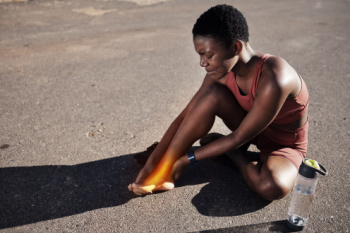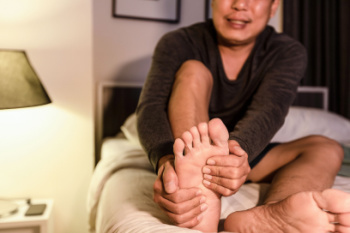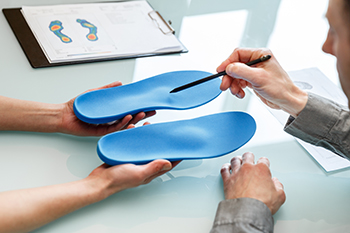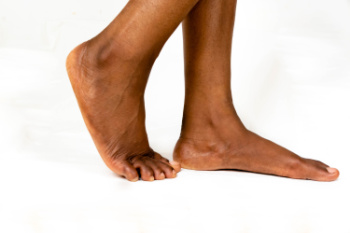Connect With Us
Blog
Items filtered by date: April 2024
Stepping Safely

Ankle sprains occur when ligaments in the ankle are stretched or torn, often due to sudden twisting movements. Common causes include sports injuries, walking or running on uneven surfaces, or accidents. Prevention involves maintaining strength and flexibility through regular exercise, wearing supportive footwear, and using caution during physical activities. Immediate treatment for ankle sprains includes rest, compression, and elevation. Gentle exercises to restore range of motion and strength may aid in recovery. However, severe sprains may require medical attention, including immobilization with a brace or splint, or, in rare cases, surgery. If you have sprained your ankle, it is suggested that you schedule an appointment with a podiatrist for a proper diagnosis and a treatment plan tailored to your individual needs.
Ankle pain can be caused by a number of problems and may be potentially serious. If you have ankle pain, consult with Steven Black, DPM from California . Our doctor will assess your condition and provide you with quality foot and ankle treatment.
Ankle pain is any condition that causes pain in the ankle. Due to the fact that the ankle consists of tendons, muscles, bones, and ligaments, ankle pain can come from a number of different conditions.
Causes
The most common causes of ankle pain include:
- Types of arthritis (rheumatoid, osteoarthritis, and gout)
- Ankle sprains
- Broken ankles
- Achilles tendonitis
- Achilles tendon rupture
- Stress fractures
- Bursitis
- Tarsal tunnel syndrome
- Plantar fasciitis
Symptoms
Symptoms of ankle injury vary based upon the condition. Pain may include general pain and discomfort, swelling, aching, redness, bruising, burning or stabbing sensations, and/or loss of sensation.
Diagnosis
Due to the wide variety of potential causes of ankle pain, podiatrists will utilize a number of different methods to properly diagnose ankle pain. This can include asking for personal and family medical histories and of any recent injuries. Further diagnosis may include sensation tests, a physical examination, and potentially x-rays or other imaging tests.
Treatment
Just as the range of causes varies widely, so do treatments. Some more common treatments are rest, ice packs, keeping pressure off the foot, orthotics and braces, medication for inflammation and pain, and surgery.
If you have any questions please feel free to contact our office located in Lancaster, CA . We offer the newest diagnostic tools and technology to treat your foot and ankle needs.
Foot Pain From Sciatica

Sciatica is a condition characterized by pain that radiates along the sciatic nerve, which runs from the lower back down through the buttocks and into each leg. When the sciatic nerve becomes compressed or irritated, it can lead to various symptoms, including sharp, shooting pain, tingling, numbness, or weakness in the lower back, buttocks, legs, and feet. In some cases, sciatica can also cause toe pain, often described as a burning sensation or electric shock-like discomfort. This toe pain may result from nerve compression affecting the branches of the sciatic nerve that innervate the feet and toes. A podiatrist can play a vital role in managing sciatica-related foot pain by conducting a comprehensive evaluation to identify contributing factors, providing treatments to alleviate symptoms such as orthotic devices, and coordinating care with other healthcare providers as needed for optimal pain management and functional improvement.
Foot Pain
Foot pain can be extremely painful and debilitating. If you have a foot pain, consult with Steven Black, DPM from California . Our doctor will assess your condition and provide you with quality foot and ankle treatment.
Causes
Foot pain is a very broad condition that could be caused by one or more ailments. The most common include:
- Bunions
- Hammertoes
- Plantar Fasciitis
- Bone Spurs
- Corns
- Tarsal Tunnel Syndrome
- Ingrown Toenails
- Arthritis (such as Gout, Rheumatoid, and Osteoarthritis)
- Flat Feet
- Injury (from stress fractures, broken toe, foot, ankle, Achilles tendon ruptures, and sprains)
- And more
Diagnosis
To figure out the cause of foot pain, podiatrists utilize several different methods. This can range from simple visual inspections and sensation tests to X-rays and MRI scans. Prior medical history, family medical history, and any recent physical traumatic events will all be taken into consideration for a proper diagnosis.
Treatment
Treatment depends upon the cause of the foot pain. Whether it is resting, staying off the foot, or having surgery; podiatrists have a number of treatment options available for foot pain.
If you have any questions, please feel free to contact our office located in Lancaster, CA . We offer the newest diagnostic and treatment technologies for all your foot care needs.
Diabetes and Neuropathy
 Diabetes can lead to a condition known as neuropathy, a type of nerve damage that often affects the legs and feet, due to high blood sugar levels over time. High blood sugar can harm the tiny blood vessels that supply nerves, especially those in the lower extremities. This can cause symptoms ranging from tingling, numbness, and pain in the feet to more severe issues like loss of sensation. The loss of feeling is particularly concerning because it can make it difficult for someone to notice injuries or infections. This, in turn, heightens the risk of serious complications, such as foot ulcers and infections that heal poorly. Managing blood sugar levels is important for preventing or slowing the progression of neuropathy. If you are at risk for neuropathy and wound care issues, it is suggested that you have regular check-ups with a podiatrist to monitor foot health and prevent complications.
Diabetes can lead to a condition known as neuropathy, a type of nerve damage that often affects the legs and feet, due to high blood sugar levels over time. High blood sugar can harm the tiny blood vessels that supply nerves, especially those in the lower extremities. This can cause symptoms ranging from tingling, numbness, and pain in the feet to more severe issues like loss of sensation. The loss of feeling is particularly concerning because it can make it difficult for someone to notice injuries or infections. This, in turn, heightens the risk of serious complications, such as foot ulcers and infections that heal poorly. Managing blood sugar levels is important for preventing or slowing the progression of neuropathy. If you are at risk for neuropathy and wound care issues, it is suggested that you have regular check-ups with a podiatrist to monitor foot health and prevent complications.
Neuropathy
Neuropathy can be a potentially serious condition, especially if it is left undiagnosed. If you have any concerns that you may be experiencing nerve loss in your feet, consult with Steven Black, DPM from California . Our doctor will assess your condition and provide you with quality foot and ankle treatment for neuropathy.
What Is Neuropathy?
Neuropathy is a condition that leads to damage to the nerves in the body. Peripheral neuropathy, or neuropathy that affects your peripheral nervous system, usually occurs in the feet. Neuropathy can be triggered by a number of different causes. Such causes include diabetes, infections, cancers, disorders, and toxic substances.
Symptoms of Neuropathy Include:
- Numbness
- Sensation loss
- Prickling and tingling sensations
- Throbbing, freezing, burning pains
- Muscle weakness
Those with diabetes are at serious risk due to being unable to feel an ulcer on their feet. Diabetics usually also suffer from poor blood circulation. This can lead to the wound not healing, infections occurring, and the limb may have to be amputated.
Treatment
To treat neuropathy in the foot, podiatrists will first diagnose the cause of the neuropathy. Figuring out the underlying cause of the neuropathy will allow the podiatrist to prescribe the best treatment, whether it be caused by diabetes, toxic substance exposure, infection, etc. If the nerve has not died, then it’s possible that sensation may be able to return to the foot.
Pain medication may be issued for pain. Electrical nerve stimulation can be used to stimulate nerves. If the neuropathy is caused from pressure on the nerves, then surgery may be necessary.
If you have any questions, please feel free to contact our office located in Lancaster, CA . We offer the newest diagnostic and treatment technologies for all your foot care needs.
It's Time for Beautiful Feet
Podiatrists Are Masters of Foot Orthotics

Orthotics, specialized shoe inserts designed to support and align the foot and ankle, are crafted by a myriad of companies worldwide. However, amidst this diversity, podiatrists stand out as experts in the field. These healthcare professionals possess extensive knowledge of foot anatomy, biomechanics, and gait analysis, enabling them to tailor orthotic solutions to individual needs effectively. Unlike mass-produced inserts, podiatrists meticulously assess each patient's unique requirements, accounting for factors like foot structure, medical history, and lifestyle. This personalized approach ensures optimal fit and function, addressing a wide range of conditions, from plantar fasciitis to diabetic foot complications. Podiatrists employ a variety of techniques and materials, including foam impressions, computerized scans, and custom molds to create orthotics that provide maximum comfort and support. Furthermore, they offer ongoing care and adjustments, ensuring patients experience lasting relief and improved mobility. If you experience foot or ankle discomfort, it is suggested that you schedule an appointment with a podiatrist to discuss whether custom-made orthotics can help you.
If you are having discomfort in your feet and would like to try orthotics, contact Steven Black, DPM from California . Our doctor can provide the care you need to keep you pain-free and on your feet.
What Are Orthotics?
Orthotics are inserts you can place into your shoes to help with a variety of foot problems such as flat feet or foot pain. Orthotics provide relief and comfort for minor foot and heel pain but can’t correct serious biomechanical problems in your feet.
Over-the-Counter Inserts
Orthotics come in a wide variety of over-the-counter inserts that are used to treat foot pain, heel pain, and minor problems. For example, arch supports can be inserted into your shoes to help correct overarched or flat feet, while gel insoles are often used because they provide comfort and relief from foot and heel pain by alleviating pressure.
Prescription Orthotics
If over-the-counter inserts don’t work for you or if you have a more severe foot concern, it is possible to have your podiatrist prescribe custom orthotics. These high-quality inserts are designed to treat problems such as abnormal motion, plantar fasciitis, and severe forms of heel pain. They can even be used to help patients suffering from diabetes by treating foot ulcers and painful calluses and are usually molded to your feet individually, which allows them to provide full support and comfort.
If you are experiencing minor to severe foot or heel pain, it’s recommended to speak with your podiatrist about the possibilities of using orthotics. A podiatrist can determine which type of orthotic is right for you and allow you to take the first steps towards being pain-free.
If you have any questions please contact our office located in Lancaster, CA . We offer the newest diagnostic and treatment technologies for all your foot and ankle needs.
When Are Flat Feet a Problem?

Flat feet, or pes planus, is a common condition where the arches of the feet collapse, causing the entire sole to touch the ground. It affects approximately 20 to 30 percent of the population and can occur in both children and adults. Flat feet may develop due to specific factors, including genetics, weak foot muscles, injury, or certain medical conditions. People at higher risk include those with family history, obesity, diabetes, or who stand for long periods of time. There are different types of flat feet. Flexible flat feet are where the arches only flatten when weight is applied. Tight Achilles tendon limits foot movement. Posterior tibial tendon dysfunction is when the tendon supporting the arch becomes weakened. Treatment by a podiatrist aims to relieve painful symptoms and improve foot function. This may involve custom orthotic devices, stretching exercises, supportive footwear, or in severe cases, surgery to reconstruct the arch. If you have problematic flat feet, it is suggested that you schedule an appointment with a podiatrist for proper management and relief.
Flatfoot is a condition many people suffer from. If you have flat feet, contact Steven Black, DPM from California . Our doctor will treat your foot and ankle needs.
What Are Flat Feet?
Flatfoot is a condition in which the arch of the foot is depressed and the sole of the foot is almost completely in contact with the ground. About 20-30% of the population generally has flat feet because their arches never formed during growth.
Conditions & Problems:
Having flat feet makes it difficult to run or walk because of the stress placed on the ankles.
Alignment – The general alignment of your legs can be disrupted, because the ankles move inward which can cause major discomfort.
Knees – If you have complications with your knees, flat feet can be a contributor to arthritis in that area.
Symptoms
- Pain around the heel or arch area
- Trouble standing on the tip toe
- Swelling around the inside of the ankle
- Flat look to one or both feet
- Having your shoes feel uneven when worn
Treatment
If you are experiencing pain and stress on the foot you may weaken the posterior tibial tendon, which runs around the inside of the ankle.
If you have any questions please feel free to contact our office located in Lancaster, CA . We offer the newest diagnostic and treatment technologies for all your foot and ankle needs.
Blog Archives
- December 2025
- November 2025
- October 2025
- September 2025
- August 2025
- July 2025
- June 2025
- May 2025
- April 2025
- March 2025
- February 2025
- January 2025
- December 2024
- November 2024
- October 2024
- September 2024
- August 2024
- July 2024
- June 2024
- May 2024
- April 2024
- March 2024
- February 2024
- January 2024
- December 2023
- November 2023
- October 2023
- September 2023
- August 2023
- July 2023
- June 2023
- May 2023
- April 2023
- March 2023
- February 2023
- January 2023
- December 2022
- November 2022
- October 2022
- September 2022
- August 2022
- July 2022
- June 2022

